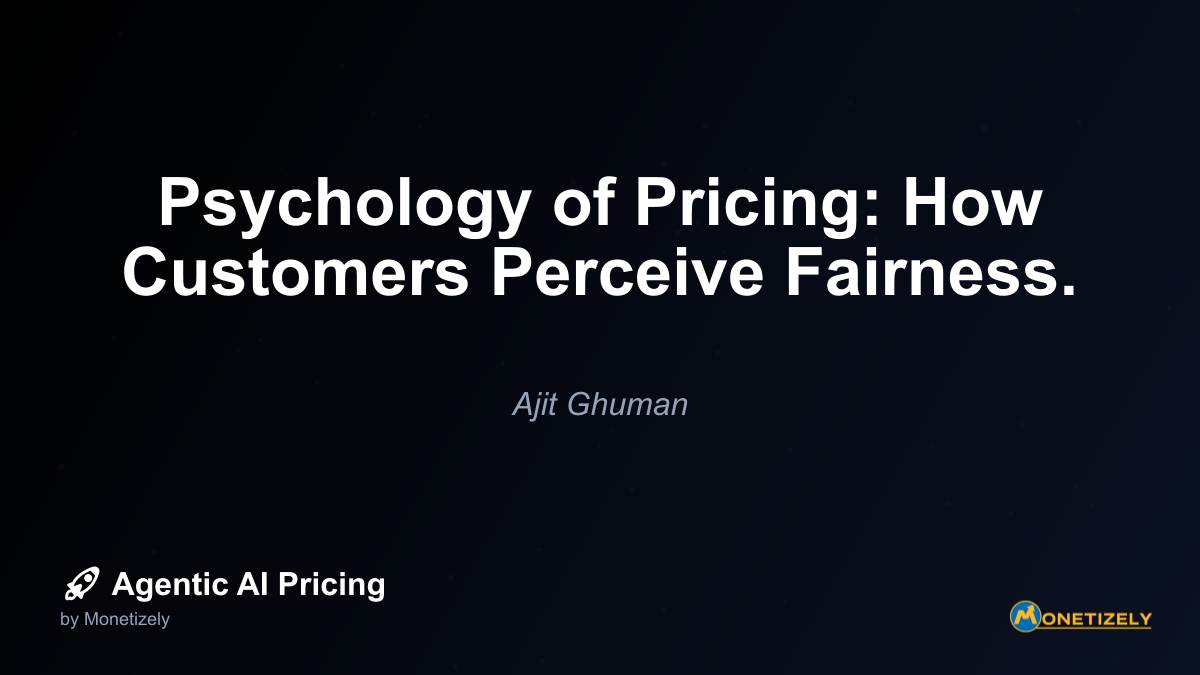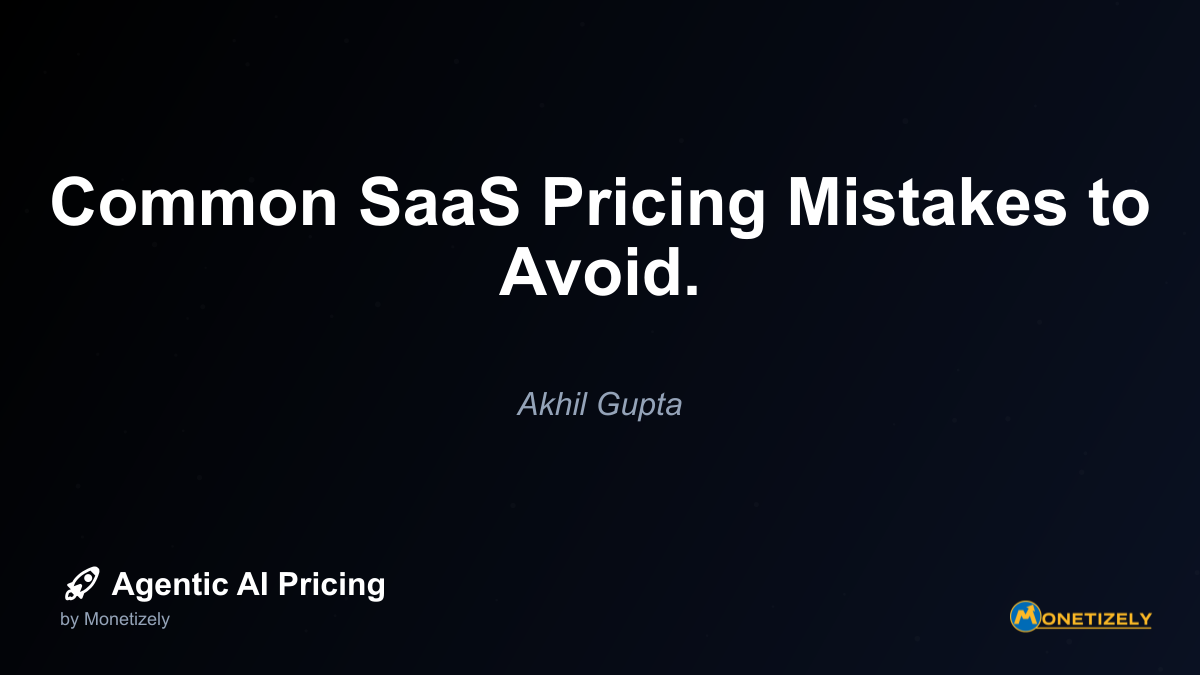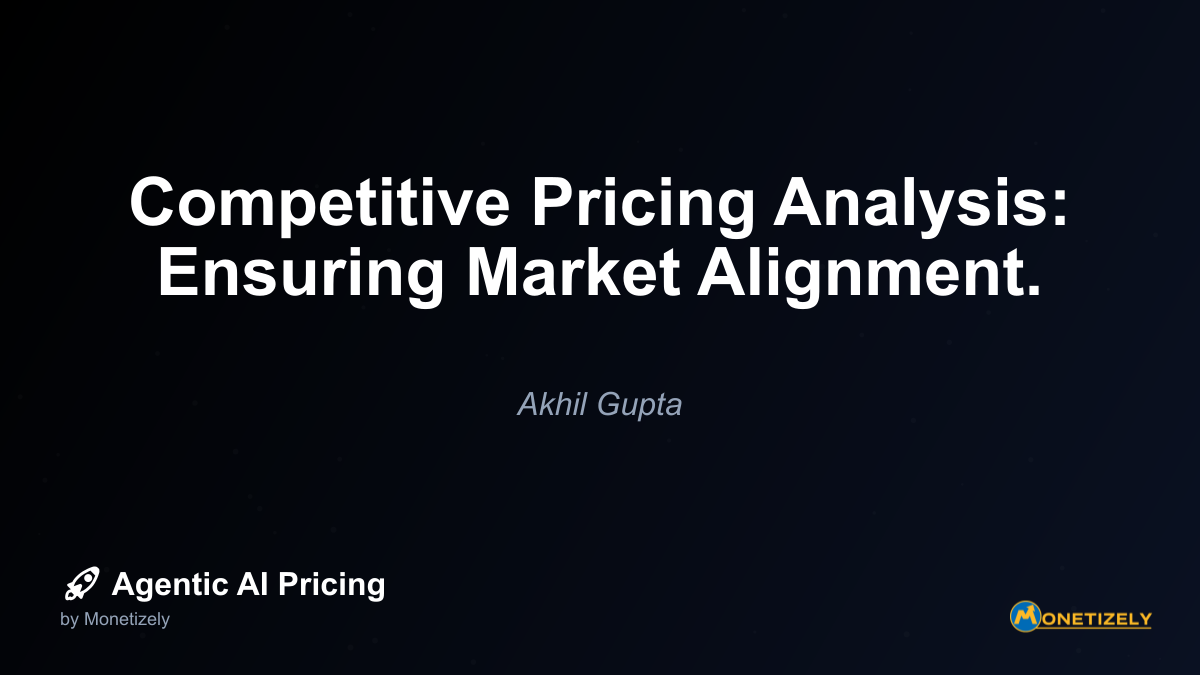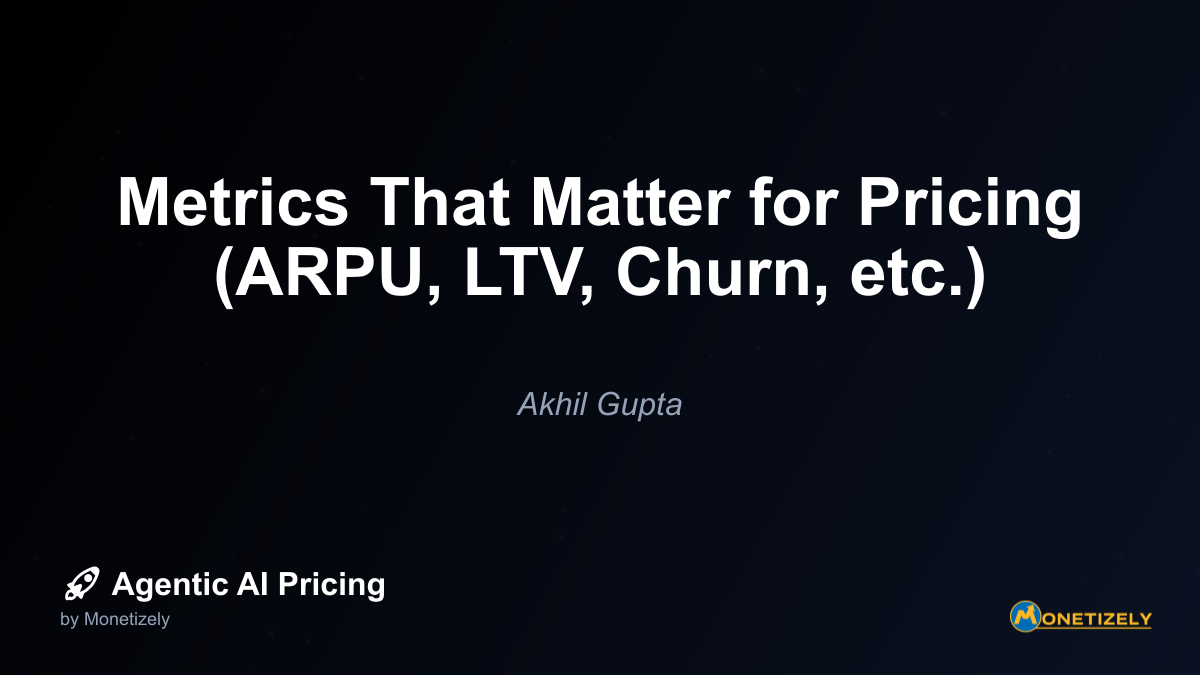· Ajit Ghuman · Pricing Fundamentals · 10 min read
Psychology of Pricing: How Customers Perceive Fairness.
AI and SaaS Pricing Masterclass
Learn the art of strategic pricing directly from industry experts. Our comprehensive course provides frameworks and methodologies for optimizing your pricing strategy in the evolving AI landscape. Earn a professional certification that can be imported directly to your LinkedIn profile.

The psychology of pricing represents one of the most fascinating intersections of business strategy and human behavior. When customers encounter a price, they don’t simply process it as a numerical value—they evaluate it through complex psychological filters shaped by expectations, context, and personal values. This psychological dimension becomes particularly crucial when introducing innovative pricing models for emerging technologies like agentic AI.
Understanding how customers perceive fairness in pricing isn’t merely academic—it directly impacts conversion rates, customer satisfaction, and long-term loyalty. For companies deploying AI solutions with novel pricing structures, mastering these psychological principles can mean the difference between market acceptance and rejection.
The Foundations of Price Perception
At its core, price perception revolves around a fundamental question in the customer’s mind: “Am I getting a fair deal?” This evaluation happens almost instantaneously and relies on several psychological mechanisms that have been extensively studied.
Reference Points and Anchoring
Customers rarely evaluate prices in isolation. Instead, they judge them against reference points—previous experiences, competitor offerings, or initial price points they’ve encountered. This phenomenon, known as anchoring, significantly influences how subsequent prices are perceived.
When a customer first sees a price of $100 for an AI assistant subscription, that figure becomes anchored in their mind. If they later encounter a premium version priced at $130, they’ll evaluate it relative to the $100 anchor, potentially seeing it as a reasonable upgrade. Conversely, if they first see a competitor’s offering at $70, the $100 price point might suddenly seem excessive.
For agentic AI pricing, establishing appropriate anchors becomes critical. Many companies strategically present their premium tiers first, anchoring customers to higher price points before revealing more affordable options. This makes the standard tier feel like a bargain by comparison, even if it would have seemed expensive in isolation.
The Contrast Principle
Closely related to anchoring is the contrast principle. When presented with two distinctly different options in sequence, customers perceive the second option as more different than it actually is.
This explains why many SaaS companies present their enterprise tier (with significantly higher pricing) alongside their standard offerings. The contrast makes the standard tier seem more affordable, even when its absolute price hasn’t changed. For agentic AI products with tiered capabilities, strategically creating contrast between tiers can guide customers toward the intended selection.
Fairness Perceptions in Pricing
Fairness perception extends beyond simple numerical comparisons and delves into more complex psychological territory.
The Dual Entitlement Principle
According to the dual entitlement principle, customers believe they are entitled to a reasonable price, while companies are entitled to a reasonable profit. When either side appears to violate this implicit contract, perceptions of unfairness emerge.
This becomes particularly relevant for AI pricing models that might appear to generate excessive profits with minimal marginal costs. When customers perceive that an AI company is exploiting its position to extract disproportionate value, resistance follows—even if the absolute price point might be acceptable in different circumstances.
Cost-Plus vs. Value-Based Perceptions
Traditionally, many customers assume prices are determined primarily by costs plus a reasonable markup (cost-plus pricing). However, modern pricing strategies, especially for AI products, often follow value-based approaches where prices reflect the value delivered rather than production costs.
This disconnect between how companies price their offerings and how customers expect prices to be determined creates tension. When an agentic AI solution delivers $10,000 in value but costs only $50 to produce and maintain, what constitutes a “fair” price? The company might justifiably charge $2,000 based on value, while customers might expect something closer to $100 based on perceived costs.
Bridging this perception gap requires careful communication about the value created rather than focusing on the technical delivery mechanisms.
Transparency and Trust in Pricing
Perhaps no factor influences fairness perception more profoundly than transparency. Customers who understand the rationale behind pricing decisions are significantly more likely to perceive them as fair.
The Hidden Costs of Opaque Pricing
When pricing structures lack transparency, customers often assume the worst—that companies are hiding something or attempting to extract unfair value. This suspicion leads to hesitation, reduced conversion rates, and potentially damaged brand perception.
For agentic AI companies, whose technologies might already face trust challenges, pricing opacity can compound existing concerns. Clear communication about how prices are determined, what factors influence them, and what value customers receive becomes essential.
The Transparency Premium
Research consistently shows that companies practicing transparent pricing can actually command premium prices. When customers understand the value equation and trust the company’s intentions, their price sensitivity decreases.
For example, an agentic AI company might explain: “Our pricing reflects our investment in continuous model improvement, data security, and ethical oversight. While basic automation tools cost less, our advanced reasoning capabilities deliver 5x the productivity improvement.” This transparency transforms what might seem like an arbitrary price difference into a rational value proposition.
Psychological Pricing Tactics and Their Effectiveness
Beyond foundational principles, specific tactical approaches leverage psychological biases to influence price perception.
The Power of 9s and Precision Pricing
The enduring popularity of prices ending in 9 (like $199 instead of $200) stems from their psychological impact. Research confirms that these prices are perceived as significantly lower than their rounded counterparts, activating a “bargain” perception in customers’ minds.
More recently, studies have shown that precise prices (like $102.37 instead of $100) are perceived as more thoughtfully determined and potentially more fair—customers assume the precision reflects actual cost calculations rather than arbitrary markups.
For agentic AI products, especially those with usage-based components, precise pricing can signal sophistication and fairness in the pricing algorithm.
Decoy Pricing and Choice Architecture
The introduction of a strategically designed “decoy” option can dramatically influence customer choices. When customers see three options—budget, standard, and premium—the middle option often gains popularity if the premium option provides a useful comparison point.
This principle explains why many AI platforms offer three-tier pricing with the middle tier highlighted as “most popular.” The highest tier isn’t necessarily expected to generate significant sales; its primary purpose is to make the middle tier appear more reasonable.
Bundling Psychology
Bundling multiple features or services together leverages several psychological principles simultaneously:
- It obscures the individual prices of components, reducing price sensitivity
- It creates a perception of greater overall value
- It simplifies decision-making by reducing choice complexity
For agentic AI products with multiple capabilities, thoughtful bundling can address fairness concerns by emphasizing the comprehensive solution rather than individual component pricing.
Fairness in Dynamic and Personalized Pricing
As AI enables increasingly sophisticated pricing approaches, new psychological challenges emerge around fairness perception.
The Fairness Paradox in Dynamic Pricing
Dynamic pricing—adjusting prices based on demand, time, customer segment, or other factors—creates efficiency from an economic perspective but often triggers fairness concerns. Customers who discover they paid more than others for identical services frequently experience a sense of being treated unfairly, even when the price differences reflect legitimate market factors.
For agentic AI platforms considering dynamic pricing models, the transparency challenge becomes particularly acute. How do you explain price variations without creating perceptions of discrimination or exploitation?
The Personalization Dilemma
Personalized pricing—tailoring prices to individual customers’ willingness to pay—presents an even thornier psychological challenge. While economically efficient, it directly conflicts with most customers’ sense of fairness, which typically assumes everyone should pay the same price for the same service.
This explains why most companies implement personalization indirectly through discounting strategies, feature differentiation, or segment-based pricing rather than overtly charging different customers different amounts.
Cultural Dimensions of Price Fairness
Price fairness perceptions aren’t universal—they vary significantly across cultural contexts, adding another layer of complexity for global AI pricing strategies.
Individualist vs. Collectivist Societies
In individualist societies like the United States, customers often evaluate fairness based on personal outcomes—“Am I getting a good deal?” In more collectivist societies like many Asian countries, fairness evaluations may include broader considerations—“Are we all being treated equitably?”
This distinction affects how pricing communications should be framed. In individualist markets, emphasizing personal value and return on investment resonates, while collectivist markets may respond better to messages about equitable access and community benefits.
Price Negotiation Expectations
In some cultures, fixed pricing is the expected norm, while in others, negotiation is a fundamental part of the purchasing process. When these expectations clash with actual pricing practices, perceptions of unfairness can emerge.
For global agentic AI deployments, understanding these cultural variations becomes essential for adapting pricing approaches to local expectations.
Practical Applications for Agentic AI Pricing
How can these psychological principles be applied to develop more effective pricing strategies for agentic AI products?
Communicating Value Before Price
When introducing novel AI capabilities, establish value understanding before revealing prices. This sequencing allows customers to form value perceptions independently of cost considerations, reducing sticker shock and improving fairness perception.
For example, demonstrating how an agentic AI solution saves 15 hours of work weekly before discussing its $200 monthly subscription provides context that makes the price evaluation more favorable.
Framing Prices in Terms of Outcomes
Rather than pricing based on technical specifications (like tokens, API calls, or compute resources), frame prices in terms of outcomes meaningful to customers. This shifts the fairness evaluation from “What am I paying for technology?” to “What results am I achieving?”
An AI writing assistant might be priced per successful document created rather than per word generated, aligning the pricing model with customer-perceived value.
Leveraging the Segmentation-Fairness Balance
While customer segmentation enables more efficient pricing, it must be implemented thoughtfully to maintain fairness perceptions. The key is ensuring segmentation criteria feel legitimate to customers.
For instance, offering discounted AI access to educational institutions feels fair to most customers because the segmentation basis (educational purpose) seems legitimate. Conversely, charging different prices based solely on assumed ability to pay would likely trigger fairness concerns.
Creating Transparent Usage Tiers
For usage-based AI pricing models, transparent tiers with clear thresholds help customers understand and predict their costs. This predictability enhances fairness perception compared to purely variable pricing, which can create anxiety about unexpected charges.
A hybrid approach—combining a base subscription with tiered usage components—often strikes the optimal balance between flexibility and predictability.
When Pricing Perception Goes Wrong: Recovery Strategies
Even well-designed pricing strategies sometimes trigger negative reactions. How companies respond to these situations significantly impacts long-term trust and fairness perception.
The Service Recovery Paradox
Research demonstrates that effectively addressing a pricing concern can actually create stronger customer loyalty than if no problem had occurred at all. This “service recovery paradox” highlights the opportunity in pricing misperceptions.
When customers question pricing fairness, transparent explanation, empathetic listening, and good-faith resolution can transform potential detractors into advocates.
Grandfathering and Transition Strategies
When implementing pricing changes, particularly increases, how existing customers are treated dramatically affects fairness perception. Grandfathering (allowing existing customers to maintain previous pricing) often preserves relationships, though it creates revenue challenges.
Alternatively, phased transitions with advance notice and clear rationales can maintain fairness perception while eventually achieving pricing objectives.
The Future of Fair Pricing in Agentic AI
As AI capabilities continue advancing, new pricing models will emerge, presenting both opportunities and challenges for fairness perception.
Outcome-Based Pricing Models
True outcome-based pricing—where customers pay based on measurable results achieved through AI—represents the future frontier of fair pricing perception. When customers pay only for verified value received, the fairness equation fundamentally changes.
While technically challenging to implement, these models align company and customer incentives more directly than traditional subscription or usage-based approaches.
Transparent Algorithmic Pricing
As pricing itself becomes increasingly algorithmic, companies face a choice between black-box optimization and transparent pricing logic. While opacity might yield short-term revenue advantages, transparency builds long-term trust and perceived fairness.
Some forward-thinking companies are exploring ways to make their pricing algorithms explainable and even customizable, giving customers unprecedented insight into how their prices are determined.
Conclusion: Building Fair Pricing Perception by Design
The psychology of pricing fairness isn’t merely a consideration to address after developing pricing models—it should be integrated into the pricing design process from the beginning. For agentic AI companies, whose technologies are already navigating complex trust landscapes, getting pricing perception right becomes doubly important.
By understanding the psychological mechanisms behind price evaluation, companies can develop pricing strategies that feel intuitively fair to customers while achieving business objectives. This alignment creates a foundation for sustainable growth, reducing friction in the buying process and building the trust necessary for long-term customer relationships.
As AI capabilities continue evolving, the companies that thrive won’t necessarily be those with the most sophisticated technology or even the lowest prices—they’ll be the ones who master the psychology of pricing perception, creating models that customers instinctively recognize as fair, transparent, and aligned with the value they receive.
Co-Founder & CEO
Ajit is the author of Price To Scale, a top book on SaaS Pricing and is the Founder of Monetizely. Ajit has led and worked in pricing and product marketing at firms like Twilio, Narvar and Medallia. His work has been featured in Forbes and VentureBeat. Ajit regularly consults with software companies from Seed stage to post-IPO on pricing strategy. Ajit is also a highly-rated co-instructor for 'The Art of SaaS Pricing and Monetization' on Maven.
Pricing Strategy Audit
Let our experts analyze your current pricing strategy and identify opportunities for improvement. Our data-driven assessment will help you unlock untapped revenue potential and optimize your AI pricing approach.




